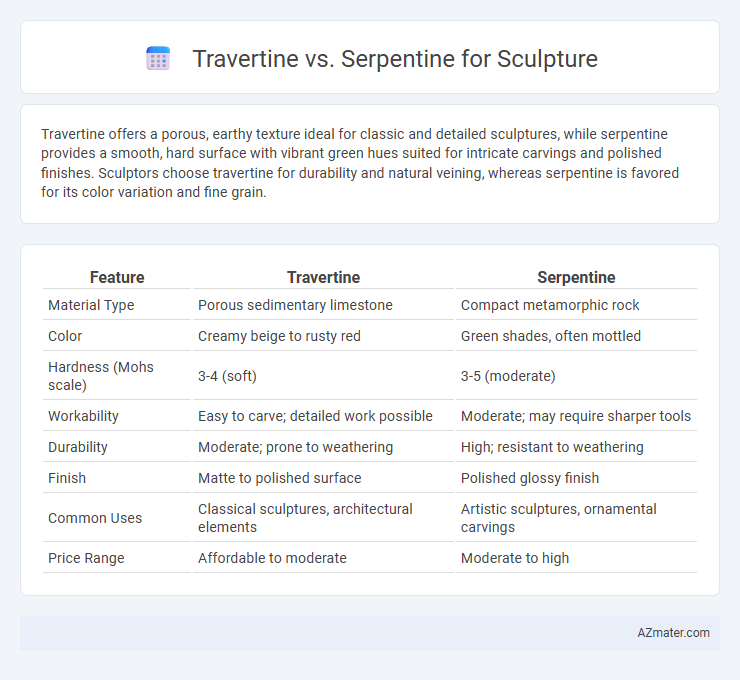Travertine offers a porous, earthy texture ideal for classic and detailed sculptures, while serpentine provides a smooth, hard surface with vibrant green hues suited for intricate carvings and polished finishes. Sculptors choose travertine for durability and natural veining, whereas serpentine is favored for its color variation and fine grain.
Table of Comparison
| Feature | Travertine | Serpentine |
|---|---|---|
| Material Type | Porous sedimentary limestone | Compact metamorphic rock |
| Color | Creamy beige to rusty red | Green shades, often mottled |
| Hardness (Mohs scale) | 3-4 (soft) | 3-5 (moderate) |
| Workability | Easy to carve; detailed work possible | Moderate; may require sharper tools |
| Durability | Moderate; prone to weathering | High; resistant to weathering |
| Finish | Matte to polished surface | Polished glossy finish |
| Common Uses | Classical sculptures, architectural elements | Artistic sculptures, ornamental carvings |
| Price Range | Affordable to moderate | Moderate to high |
Introduction to Travertine and Serpentine
Travertine is a sedimentary limestone formed by mineral springs, valued for its porous texture and warm, earthy tones that offer excellent carving detail and durability for sculpture. Serpentine, a metamorphic rock with a smooth, waxy surface and rich green hues, is prized by sculptors for its fine grain and ability to take a high polish. Both stones provide unique aesthetic qualities and workability, making them popular choices in the world of sculpture.
Geological Origins and Formation
Travertine forms from the rapid precipitation of calcium carbonate in mineral springs, primarily resulting in porous, banded sedimentary rock ideal for detailed sculpting. Serpentine originates from the metamorphism of ultramafic rocks, characterized by its dense, smooth texture and rich green tones, making it valued for polished sculpture surfaces. The distinct geological formation processes directly influence their durability, texture, and aesthetic qualities in sculpture applications.
Physical Properties Comparison
Travertine is a dense, porous sedimentary rock known for its light color range and ease of carving, making it ideal for fine detailed sculptures. Serpentine exhibits a tougher, more fibrous texture with higher resistance to weathering and ranges from green to black, offering durability and a unique aesthetic but requiring more advanced tools for sculpting. Both stones differ significantly in hardness; travertine has a Mohs hardness of about 3-4, whereas serpentine ranges between 3 and 6, influencing their suitability for different sculptural techniques and environments.
Color and Aesthetic Variations
Travertine offers warm, earthy hues ranging from creamy beige to rich caramel, featuring naturally occurring veins and porous textures that create unique visual depth in sculptures. Serpentine captivates with its vibrant greens, ranging from deep emerald to pale lime, often displaying marbled patterns and a smooth, waxy finish that enhances intricate details. The choice between travertine and serpentine significantly impacts the sculpture's aesthetic, with travertine providing rustic elegance and serpentine delivering vibrant, dynamic color variations.
Workability and Sculpting Techniques
Travertine offers excellent workability due to its porous texture, allowing sculptors to achieve intricate details with chisels and rasps, ideal for both roughing out forms and fine finishing. Serpentine, being harder and denser, requires specialized tools and more effort but permits a polished surface with a distinctive sheen, favored for smooth, flowing sculptures. Master sculptors often choose travertine for its ease of carving and serpentine for its durability and lustrous finish, influencing the selection of chiseling, sanding, and polishing techniques accordingly.
Durability and Longevity
Travertine offers excellent durability due to its dense calcium carbonate composition, making it resistant to weathering and suitable for outdoor sculptures with long-lasting structural integrity. Serpentine, while softer and easier to carve, is more susceptible to erosion and chemical weathering, leading to reduced longevity in exposed environments. For sculptures requiring enduring strength and minimal maintenance, travertine is the superior choice over serpentine.
Maintenance and Preservation
Travertine offers excellent durability with moderate porosity, requiring regular sealing to prevent staining and erosion, making its maintenance manageable for sculptures. Serpentine's softer texture and susceptibility to weathering demand careful handling and specialized conservation techniques to prevent surface degradation. Preservation of travertine sculptures benefits from routine cleaning and sealing, while serpentine pieces require controlled environments to minimize moisture and chemical exposure.
Cost and Availability
Travertine is generally more affordable and widely available due to abundant natural deposits, making it a popular choice for large outdoor sculptures and architectural details. Serpentine, often praised for its vibrant green hues and fine grain, is rarer and typically more expensive, limiting its use to smaller or premium projects. Sculptors prioritize travertine for cost-effective bulk work, while serpentine is favored for intricate, high-value pieces where aesthetic appeal justifies the higher price.
Environmental Impact
Travertine, a form of limestone, is favored for sculpture due to its natural abundance and relatively low environmental footprint during extraction, with minimal chemical processing required. Serpentine, often sourced from ultramafic rock formations, involves more intensive mining practices that can disrupt local ecosystems and release hazardous minerals. Choosing travertine over serpentine for sculpture reduces the ecological disturbance and chemical hazards associated with material sourcing and processing.
Choosing the Best Stone for Your Sculpture
Travertine offers a soft, porous texture that carves easily, making it ideal for detailed sculptures and outdoor installations due to its natural resistance to weathering. Serpentine, known for its rich green hues and smooth finish, provides greater durability and polish, perfect for intricate indoor sculptures requiring a glossy surface. Evaluating the intended environment, desired finish, and carving complexity helps determine whether travertine's workability or serpentine's durability best suits your sculptural project.

Infographic: Travertine vs Serpentine for Sculpture
 azmater.com
azmater.com